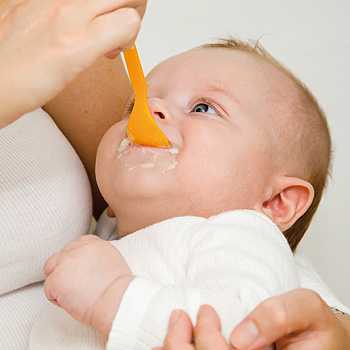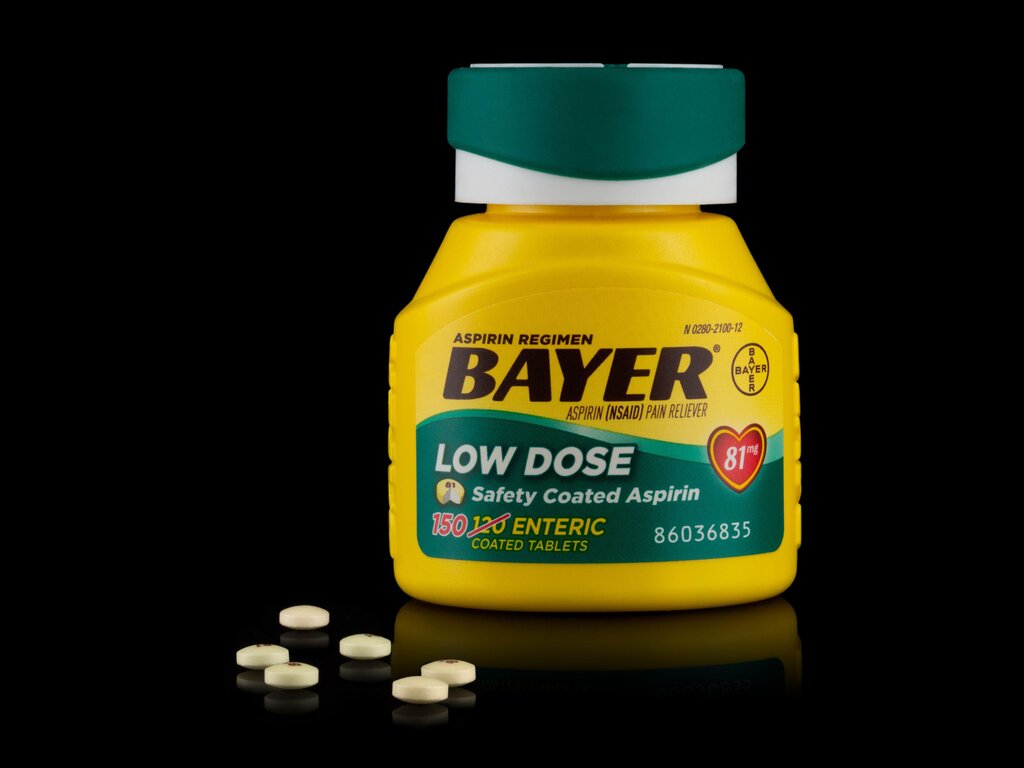Baby food and breastfeeding schedule
Tips for the First Year
Eat, sleep, pee, poop, repeat. Those are the highlights in a day of the life of a brand new baby.
And if you’re a new parent, it’s the eating part that may be the source of many of your questions and worries. How many ounces should your baby take? Do you wake a sleeping baby to eat? Why do they seem hungry all the time? When can your child start solids?
Questions abound — and, despite Grandma’s insistence, the answers have changed since you were a tot. It’s now recommended that newborns, even formula-fed ones, eat on demand (consider it good preparation for the teenage years) and that babies wait to start solid foods until they’re 4 to 6 months old.
On day one of life, your baby’s stomach is the size of a marble and can only hold 1 to 1.4 teaspoons of liquid at a time. As your baby gets older, their stomach stretches and grows.
It’s hard (or impossible, really) to know how much milk your baby is taking in while breastfeeding. But if you’re bottle feeding due to any number of valid reasons, it’s a bit easier to measure.
Here, from the American Academy of Pediatrics (AAP), a typical feeding schedule for bottle-fed babies.
| Age | Ounces per feeding | Solid foods |
|---|---|---|
| Up to 2 weeks of life | .5 oz. in the first days, then 1–3 oz. | No |
| 2 weeks to 2 months | 2–4 oz. | No |
| 2–4 months | 4-6 oz. | No |
| 4–6 months | 4–8 oz. | Possibly, if your baby can hold their head up and is at least 13 pounds. But you don’t need to introduce solid foods yet. |
| 6–12 months | 8 oz. | Yes. Start with soft foods, like one-grain cereals and pureed vegetables, meats, and fruits, progressing to mashed and well-chopped finger foods. Give your baby one new food at a time. Continue supplementing with breast or formula feedings. |
Every baby is unique — but one thing that’s pretty consistent is that breastfed babies eat more frequently than bottle-fed ones. That’s because breast milk is easily digested and empties from the stomach a lot quicker than formula.
Breastfed babies
There’s no rest for the weary. According to La Leche League International, you should begin nursing your baby within 1 hour of birth and provide about 8 to 12 feedings daily in the first few weeks of life (yeah, we’re exhausted for you).
At first, it’s important not to let your baby go more than 4 hours without feeding. You’ll likely need to wake them up if necessary, at least until breastfeeding is well established and they’re gaining weight appropriately.
As your baby grows and your milk supply amps up, your baby will be able to take in more milk in less time at one feeding. That’s when you might start to notice a more predictable pattern.
- 1 to 3 months: Your baby will feed 7 to 9 times per 24 hours.
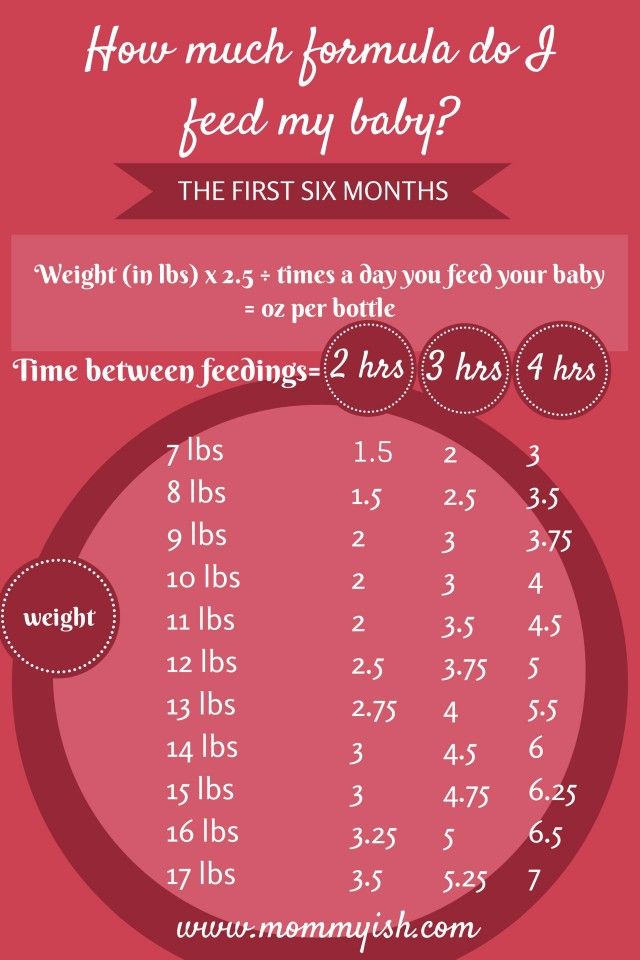
- 3 months: Feedings take place 6 to 8 times in 24 hours.
- 6 months: Your baby will feed around 6 times a day.
- 12 months: Nursing may drop to about 4 times a day. The introduction of solids at about 6 months helps to fuel your baby’s additional nutritional needs.
Keep in mind that this pattern is just one example. Different babies have different paces and preferences, along with other factors that influence the frequency of feedings.
Bottle-fed babies
Like breastfed babies, bottle-fed newborns should eat on demand. On average, that’s about every 2 to 3 hours. A typical feeding schedule may look like this:
- Newborn: every 2 to 3 hours
- At 2 months: every 3 to 4 hours
- At 4 to 6 months: every 4 to 5 hours
- At 6+ months: every 4 to 5 hours
For both breastfed and bottle-fed babies
- Don’t give liquids other than formula or breast milk to babies under a year old. That includes juices and cow’s milk.
 They don’t provide the right (if any) nutrients and can be upsetting to your baby’s tummy. Water can be introduced around 6 months when you start offering a cup.
They don’t provide the right (if any) nutrients and can be upsetting to your baby’s tummy. Water can be introduced around 6 months when you start offering a cup. - Don’t add baby cereal to a bottle.
- It can create a choking hazard.
- A baby’s digestive system isn’t mature enough to handle cereal until about 4 to 6 months of age.
- You could overfeed your baby.
- Don’t give your baby any form of honey until after their first birthday. Honey can be dangerous for a baby, occasionally causing what’s called infant botulism.
- Do adjust your expectations based on your baby and their unique needs. Premature babies are likely to follow feeding patterns according to their adjusted age. If your baby has challenges like reflux or failure to thrive, you may need to work with your doctor on the appropriate feeding schedule and amount they should be eating.
Schedules are the holy grail of every parent. Your child will naturally start to fall into a feeding pattern as their tummy grows and they can take in more breast milk or formula at one sitting.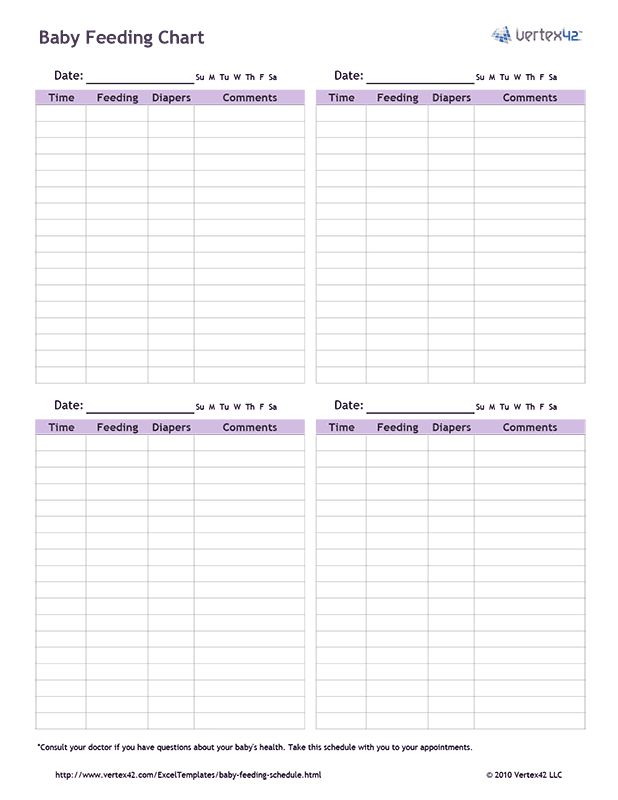 This may begin to happen between 2 and 4 months of age.
This may begin to happen between 2 and 4 months of age.
For now, though, focus on learning your baby’s hunger cues, such as:
- rooting around your chest, looking for a nipple.
- putting their fist in their mouth
- smacking or licking their lips
- fussing that can escalate quickly (don’t wait until your baby’s hangry to feed them)
Once your baby is a few months old, you may be able to introduce a sleep/feed schedule that works for you.
Let’s say, for example, your 4-month-old wakes every 5 hours for a feeding. That means if you feed at 9 p.m., your baby wakes around 2 a.m. But if you wake and feed the baby at 11 p.m., just before you go to bed, they may not rouse until 4 a.m., giving you a decent chunk of nighttime winks.
In general, if your baby seems hungry, feed them. Your baby will naturally eat more frequently during growth spurts, which typically occur around 3 weeks, 3 months, and 6 months of age.
Some babies will also “cluster feed,” meaning they’ll feed more frequently during certain periods and less at others.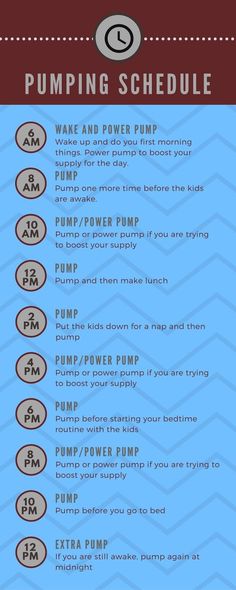 For example, your baby may cluster feed during the late afternoon and evening and then sleep longer at night (yay!). This is more common in breastfed babies than bottle fed babies.
For example, your baby may cluster feed during the late afternoon and evening and then sleep longer at night (yay!). This is more common in breastfed babies than bottle fed babies.
Worried about overfeeding? While this isn’t really possible to do with an exclusively breastfed baby, you can overfeed a baby who’s taking a bottle — especially if they’re sucking on the bottle for comfort. Follow their hunger cues, but talk to your pediatrician if you’re worried your little one may be overeating.
Your baby is probably ready for solids if they’re 4 to 6 months old and:
- have good head control
- seem interested in what you’re eating
- reach for food
- weigh 13 or more pounds
Which food to start with? The AAP now says it doesn’t really matter much in what order you introduce foods. The only real rule: Stick with one food for 3 to 5 days before offering another. If there’s an allergic reaction (rash, diarrhea, vomiting are common first signs), you’ll know which food is causing it.
As your baby grows, move from pureed baby food to ones that have more texture (for example, mashed banana, scrambled egg, or well-cooked, chopped pasta). This generally happens around 8 to 10 months of age.
Your supermarket offers a variety of baby food products, but if you want to make your own, keep it sugar and salt free. Additionally, at this stage, don’t feed your baby anything that could be a choking hazard, including:
- hard foods, such as popcorn or nuts
- hard, fresh fruits, like apples; cook to soften or chop into very small pieces
- any meat that isn’t well cooked and very well chopped (this includes hot dogs)
- cheese cubes
- peanut butter (though talk to your pediatrician about this one — and the benefits of introducing diluted peanut butter before the age of 1)
As your baby nears their first birthday, they should be eating a variety of foods and taking in about 4 ounces of solids at each meal. Continue to offer breast milk or formula.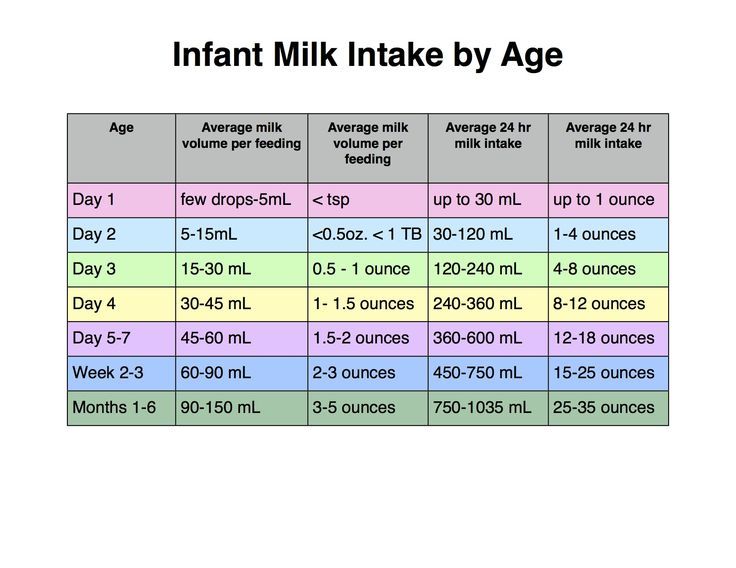 By 8 months, babies are drinking about 30 ounces a day.
By 8 months, babies are drinking about 30 ounces a day.
Oh yeah, and buy some stock in a company that makes stain-fighting laundry detergent. It’ll pay for college.
Babies aren’t cookie cutter. Some will gain weight easily, while others will have problems. Things that can affect a baby’s weight gain include:
- having a birth defect like a cleft lip or palate, which creates problems feeding
- having a milk protein intolerance
- being premature
- being fed with a bottle versus the breast
A 2012 study of more than 1,800 babies found that the infants who were fed with a bottle — regardless of whether the bottle contained breast milk or formula — gained more weight in the first year than babies who nursed exclusively.
Your baby’s doctor is the best one to advise you on a healthy weight range for your baby.
How, when, and what to feed a baby are top worries of every parent — but there’s good news: Most babies are pretty good judges of when they’re hungry and when they’re full — and they’ll let you know it.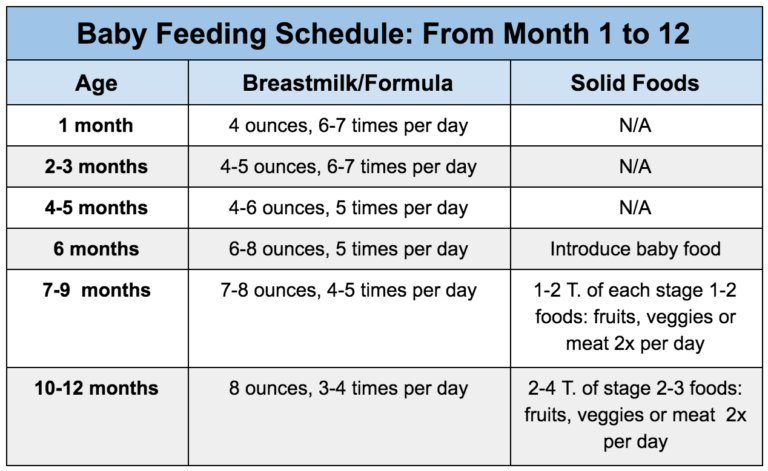
You just need to present them with the right choices at the right time and pay attention to their cues. If you have any questions or concerns, your pediatrician is there to help you along the way.
Tips for the First Year
Eat, sleep, pee, poop, repeat. Those are the highlights in a day of the life of a brand new baby.
And if you’re a new parent, it’s the eating part that may be the source of many of your questions and worries. How many ounces should your baby take? Do you wake a sleeping baby to eat? Why do they seem hungry all the time? When can your child start solids?
Questions abound — and, despite Grandma’s insistence, the answers have changed since you were a tot. It’s now recommended that newborns, even formula-fed ones, eat on demand (consider it good preparation for the teenage years) and that babies wait to start solid foods until they’re 4 to 6 months old.
On day one of life, your baby’s stomach is the size of a marble and can only hold 1 to 1.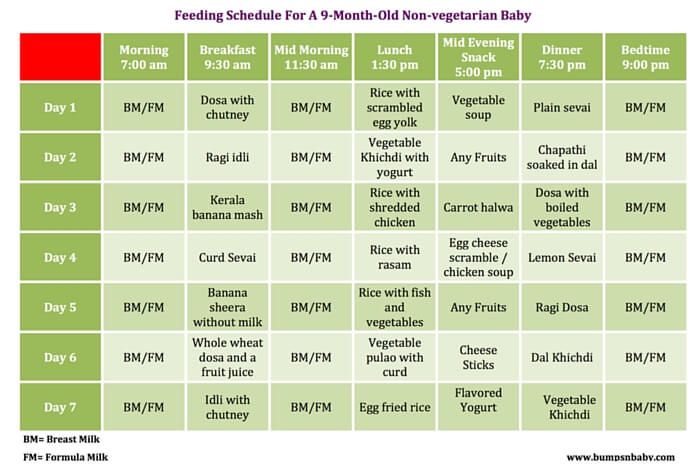 4 teaspoons of liquid at a time. As your baby gets older, their stomach stretches and grows.
4 teaspoons of liquid at a time. As your baby gets older, their stomach stretches and grows.
It’s hard (or impossible, really) to know how much milk your baby is taking in while breastfeeding. But if you’re bottle feeding due to any number of valid reasons, it’s a bit easier to measure.
Here, from the American Academy of Pediatrics (AAP), a typical feeding schedule for bottle-fed babies.
| Age | Ounces per feeding | Solid foods |
|---|---|---|
| Up to 2 weeks of life | .5 oz. in the first days, then 1–3 oz. | No |
| 2 weeks to 2 months | 2–4 oz. | No |
| 2–4 months | 4-6 oz. | No |
| 4–6 months | 4–8 oz. | Possibly, if your baby can hold their head up and is at least 13 pounds. But you don’t need to introduce solid foods yet. |
| 6–12 months | 8 oz. | Yes. Start with soft foods, like one-grain cereals and pureed vegetables, meats, and fruits, progressing to mashed and well-chopped finger foods. Give your baby one new food at a time. Continue supplementing with breast or formula feedings. Give your baby one new food at a time. Continue supplementing with breast or formula feedings. |
Every baby is unique — but one thing that’s pretty consistent is that breastfed babies eat more frequently than bottle-fed ones. That’s because breast milk is easily digested and empties from the stomach a lot quicker than formula.
Breastfed babies
There’s no rest for the weary. According to La Leche League International, you should begin nursing your baby within 1 hour of birth and provide about 8 to 12 feedings daily in the first few weeks of life (yeah, we’re exhausted for you).
At first, it’s important not to let your baby go more than 4 hours without feeding. You’ll likely need to wake them up if necessary, at least until breastfeeding is well established and they’re gaining weight appropriately.
As your baby grows and your milk supply amps up, your baby will be able to take in more milk in less time at one feeding. That’s when you might start to notice a more predictable pattern.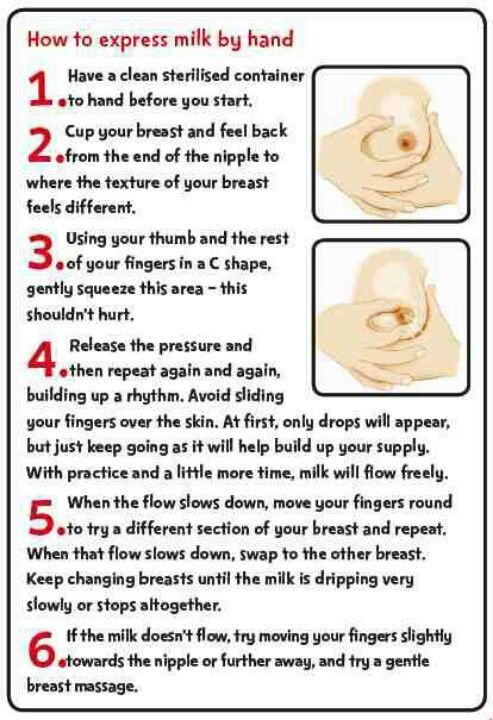
- 1 to 3 months: Your baby will feed 7 to 9 times per 24 hours.
- 3 months: Feedings take place 6 to 8 times in 24 hours.
- 6 months: Your baby will feed around 6 times a day.
- 12 months: Nursing may drop to about 4 times a day. The introduction of solids at about 6 months helps to fuel your baby’s additional nutritional needs.
Keep in mind that this pattern is just one example. Different babies have different paces and preferences, along with other factors that influence the frequency of feedings.
Bottle-fed babies
Like breastfed babies, bottle-fed newborns should eat on demand. On average, that’s about every 2 to 3 hours. A typical feeding schedule may look like this:
- Newborn: every 2 to 3 hours
- At 2 months: every 3 to 4 hours
- At 4 to 6 months: every 4 to 5 hours
- At 6+ months: every 4 to 5 hours
For both breastfed and bottle-fed babies
- Don’t give liquids other than formula or breast milk to babies under a year old.
 That includes juices and cow’s milk. They don’t provide the right (if any) nutrients and can be upsetting to your baby’s tummy. Water can be introduced around 6 months when you start offering a cup.
That includes juices and cow’s milk. They don’t provide the right (if any) nutrients and can be upsetting to your baby’s tummy. Water can be introduced around 6 months when you start offering a cup. - Don’t add baby cereal to a bottle.
- It can create a choking hazard.
- A baby’s digestive system isn’t mature enough to handle cereal until about 4 to 6 months of age.
- You could overfeed your baby.
- Don’t give your baby any form of honey until after their first birthday. Honey can be dangerous for a baby, occasionally causing what’s called infant botulism.
- Do adjust your expectations based on your baby and their unique needs. Premature babies are likely to follow feeding patterns according to their adjusted age. If your baby has challenges like reflux or failure to thrive, you may need to work with your doctor on the appropriate feeding schedule and amount they should be eating.
Schedules are the holy grail of every parent. Your child will naturally start to fall into a feeding pattern as their tummy grows and they can take in more breast milk or formula at one sitting.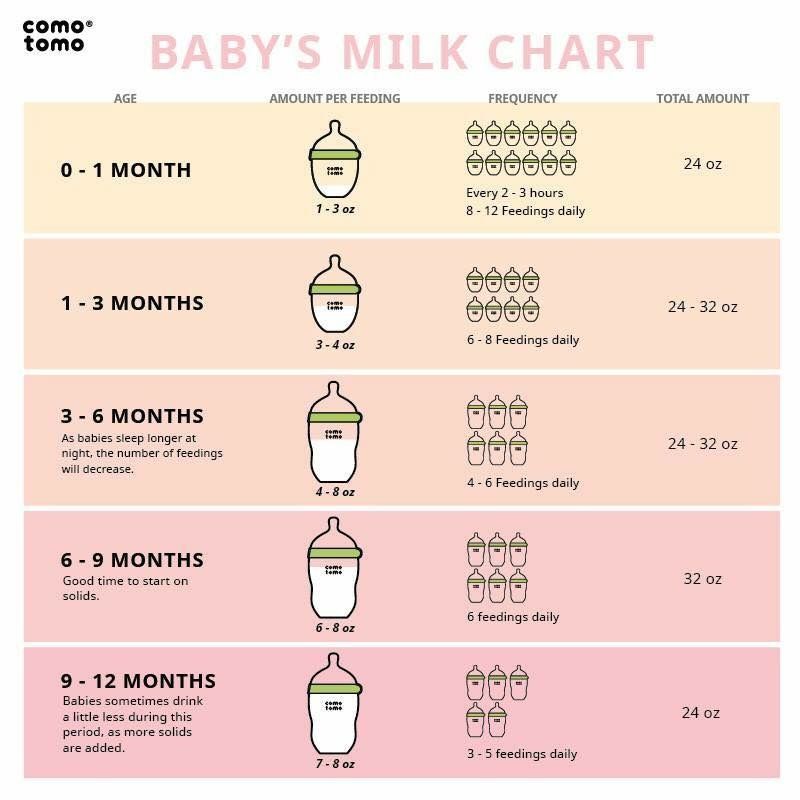 This may begin to happen between 2 and 4 months of age.
This may begin to happen between 2 and 4 months of age.
For now, though, focus on learning your baby’s hunger cues, such as:
- rooting around your chest, looking for a nipple.
- putting their fist in their mouth
- smacking or licking their lips
- fussing that can escalate quickly (don’t wait until your baby’s hangry to feed them)
Once your baby is a few months old, you may be able to introduce a sleep/feed schedule that works for you.
Let’s say, for example, your 4-month-old wakes every 5 hours for a feeding. That means if you feed at 9 p.m., your baby wakes around 2 a.m. But if you wake and feed the baby at 11 p.m., just before you go to bed, they may not rouse until 4 a.m., giving you a decent chunk of nighttime winks.
In general, if your baby seems hungry, feed them. Your baby will naturally eat more frequently during growth spurts, which typically occur around 3 weeks, 3 months, and 6 months of age.
Some babies will also “cluster feed,” meaning they’ll feed more frequently during certain periods and less at others. For example, your baby may cluster feed during the late afternoon and evening and then sleep longer at night (yay!). This is more common in breastfed babies than bottle fed babies.
For example, your baby may cluster feed during the late afternoon and evening and then sleep longer at night (yay!). This is more common in breastfed babies than bottle fed babies.
Worried about overfeeding? While this isn’t really possible to do with an exclusively breastfed baby, you can overfeed a baby who’s taking a bottle — especially if they’re sucking on the bottle for comfort. Follow their hunger cues, but talk to your pediatrician if you’re worried your little one may be overeating.
Your baby is probably ready for solids if they’re 4 to 6 months old and:
- have good head control
- seem interested in what you’re eating
- reach for food
- weigh 13 or more pounds
Which food to start with? The AAP now says it doesn’t really matter much in what order you introduce foods. The only real rule: Stick with one food for 3 to 5 days before offering another. If there’s an allergic reaction (rash, diarrhea, vomiting are common first signs), you’ll know which food is causing it.
As your baby grows, move from pureed baby food to ones that have more texture (for example, mashed banana, scrambled egg, or well-cooked, chopped pasta). This generally happens around 8 to 10 months of age.
Your supermarket offers a variety of baby food products, but if you want to make your own, keep it sugar and salt free. Additionally, at this stage, don’t feed your baby anything that could be a choking hazard, including:
- hard foods, such as popcorn or nuts
- hard, fresh fruits, like apples; cook to soften or chop into very small pieces
- any meat that isn’t well cooked and very well chopped (this includes hot dogs)
- cheese cubes
- peanut butter (though talk to your pediatrician about this one — and the benefits of introducing diluted peanut butter before the age of 1)
As your baby nears their first birthday, they should be eating a variety of foods and taking in about 4 ounces of solids at each meal. Continue to offer breast milk or formula. By 8 months, babies are drinking about 30 ounces a day.
By 8 months, babies are drinking about 30 ounces a day.
Oh yeah, and buy some stock in a company that makes stain-fighting laundry detergent. It’ll pay for college.
Babies aren’t cookie cutter. Some will gain weight easily, while others will have problems. Things that can affect a baby’s weight gain include:
- having a birth defect like a cleft lip or palate, which creates problems feeding
- having a milk protein intolerance
- being premature
- being fed with a bottle versus the breast
A 2012 study of more than 1,800 babies found that the infants who were fed with a bottle — regardless of whether the bottle contained breast milk or formula — gained more weight in the first year than babies who nursed exclusively.
Your baby’s doctor is the best one to advise you on a healthy weight range for your baby.
How, when, and what to feed a baby are top worries of every parent — but there’s good news: Most babies are pretty good judges of when they’re hungry and when they’re full — and they’ll let you know it.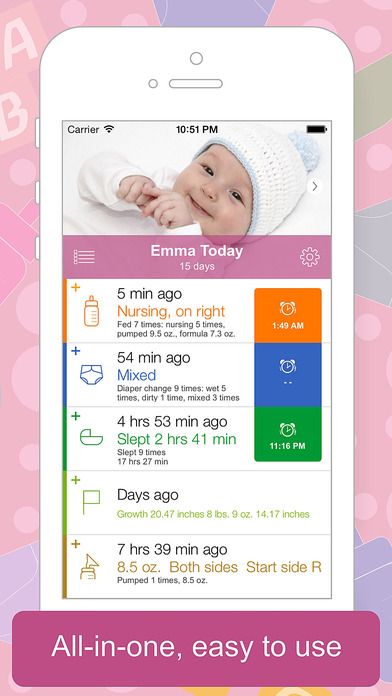
You just need to present them with the right choices at the right time and pay attention to their cues. If you have any questions or concerns, your pediatrician is there to help you along the way.
Breastfeeding and its benefits for the normal development of the infant.
Mother's milk is a natural biological product that provides physiologically adequate nutrition for babies. This is the "gold standard" of early childhood nutrition, and far from all aspects of its multifaceted influence have been studied.
A breastfed mother can follow different dietary patterns for her baby. Free feeding, or "on demand" feeding, is the diet of a child of the first year of life, when the mother puts the child to the breast as many times and at the time as the child requires, including at night. The duration of feeding is also determined by the child. It is more often carried out in the first months of life and with exclusive breastfeeding. Regulated feeding is such a diet of a child when feedings are carried out at more or less fixed hours, the frequency and volume of feedings is recommended by the doctor, taking into account the age, body weight, appetite and individual characteristics of the child.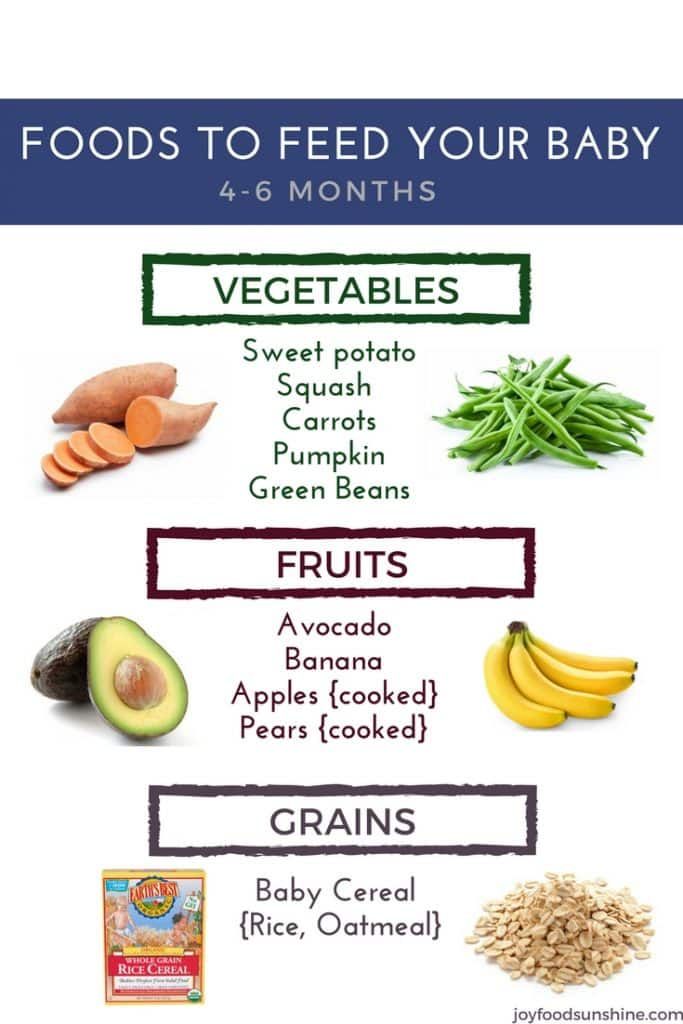 It is more often carried out after 1-2 months of life, especially with the option of mixed feeding. The duration of feeding of newborns ranges from 20 to 30 minutes, and for children older than 1 month - from 10 to 20 minutes. The water requirement of children in the first months of life is satisfied by breast milk with a sufficient level of lactation, so they do not need additional drinking.
It is more often carried out after 1-2 months of life, especially with the option of mixed feeding. The duration of feeding of newborns ranges from 20 to 30 minutes, and for children older than 1 month - from 10 to 20 minutes. The water requirement of children in the first months of life is satisfied by breast milk with a sufficient level of lactation, so they do not need additional drinking.
The criteria for a sufficient level of lactation are normal daily diuresis (600-700 ml), weight gain adequate to the age of the child and psychomotor development. If you suspect a lack of milk, you should determine the daily volume of lactation using control weighing and compare it with the calculated one, take measures to restore lactation or introduce supplementary feeding.
Breast milk is the most complex biologically active substance with unique properties:
- regulation of the processes of growth, development and differentiation of tissues;
- anti-infective protection;
- formation of immunological tolerance to dietary antigens;
- influence on the formation of the maxillofacial skeleton, speech, hearing;
- prevention of obesity, diabetes, atherosclerosis;
- beneficial effect on mental and behavioral responses, intelligence, learning ability and social adaptation;
- reduced risk of cancer in the mother, contraceptive effect in the first months of lactation.

Breast milk provides anti-inflammatory (antioxidants, enzymes that break down pro-inflammatory neurotransmitters, anti-inflammatory cytokines) and immunomodulatory substances (live CD4 and CD8 lymphocytes, nucleotides, IgA, cytokines IL-2, IL-10, IL-12, etc., soluble cytokine receptors). Breastfeeding and the state of the intestinal microflora play a key role in maintaining a balance in the Thh Th3, Th4 cytokine system. Thanks to the bifidogenic properties of human milk, a complete intestinal microbiota of the child is formed, innate immunity and protective mechanisms of the intestinal mucosa are activated, and the immune response matures.
Digestive system:
- One of the main advantages of women's milk is the proximity of its proteins in terms of qualitative composition to blood serum proteins. Breast milk contains mainly finely dispersed, that is, consisting of the smallest particles, albumin proteins, which are easily absorbed in the child's digestive tract.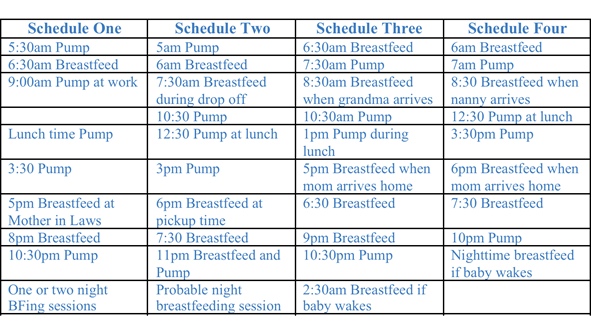
Digestibility, completeness of absorption of women's milk proteins reaches 98-99%, for cow's milk proteins this figure is much less. The main protein component of cow's milk is casein, the content of which is up to ten times higher than that in human breast milk. Casein, being a large and aggressive soluble protein, is able to penetrate the intestinal walls, forcing the child's body to produce an endogenous inflammatory mediator - histamine. What can cause both intestinal bleeding, which is fraught with the subsequent development of anemia, and various kinds of allergic reactions.
- The residence time of food in the gastrointestinal tract of the baby with natural and artificial feeding is also different. The child's stomach is freed from food after 2-3 hours with breastfeeding, and with artificial feeding - after 3-4 hours. Thus, artificial feeding puts a lot of stress on the digestive tract and on the baby's body as a whole.
- The activity of the enzyme lipase, which is responsible for the breakdown of fat in the gastrointestinal tract of the child, is much higher in human breast milk.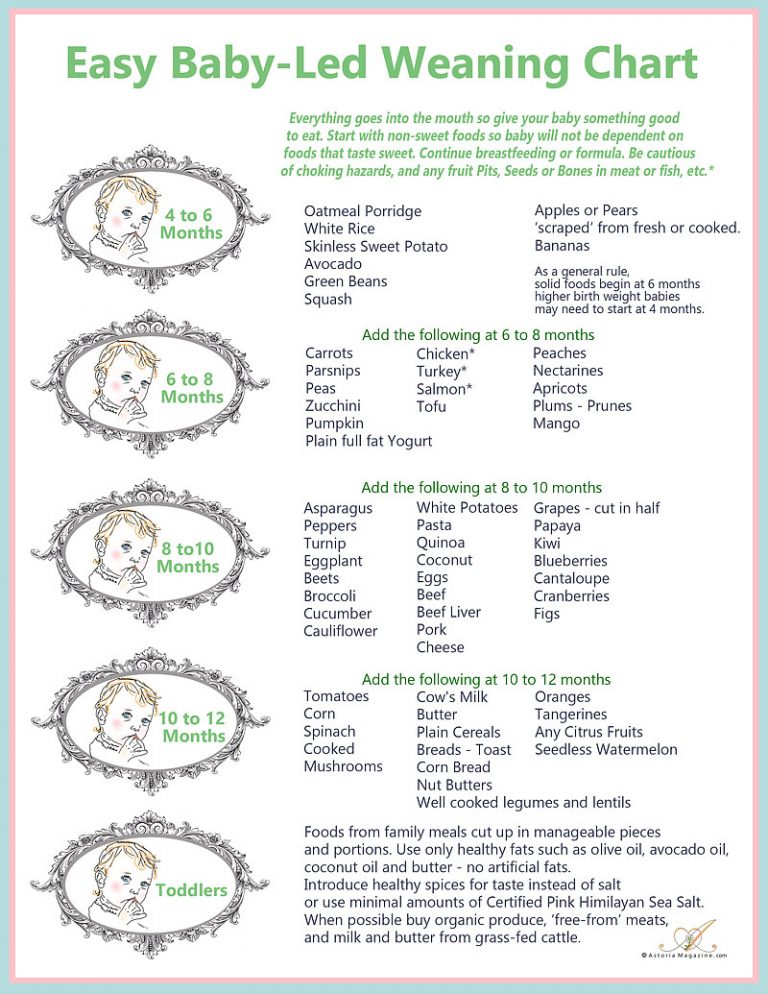 Due to the activity of maternal lipase, a high degree of fat dispersion is achieved, which facilitates their further absorption and assimilation. As a result of the action of breast milk lipase, there is a significantly lower load on the pancreas and liver of the baby, the organs responsible for the digestion of fat
Due to the activity of maternal lipase, a high degree of fat dispersion is achieved, which facilitates their further absorption and assimilation. As a result of the action of breast milk lipase, there is a significantly lower load on the pancreas and liver of the baby, the organs responsible for the digestion of fat
- Women's milk contains 5-6 times more linoleic acid. With a lack of this polyunsaturated fatty acid, a child may experience a delay in physical development, metabolism is disturbed, and adverse changes in the condition of the skin are possible.
Immune system:
- The most important advantage of mother's milk in comparison with its artificial substitutes is the presence in it of a large group of substances that protect the child's body from infections. These are secretory immunoglobulin A - sIgA, interferon, lysozyme, lactoferrin, bifidus factor, cells of the immune system.
- Immunoglobulin A is contained in secrets (fluids) on the surface of mucous membranes in contact with the external environment - lungs, nasal cavity, gastrointestinal tract, urinary tract.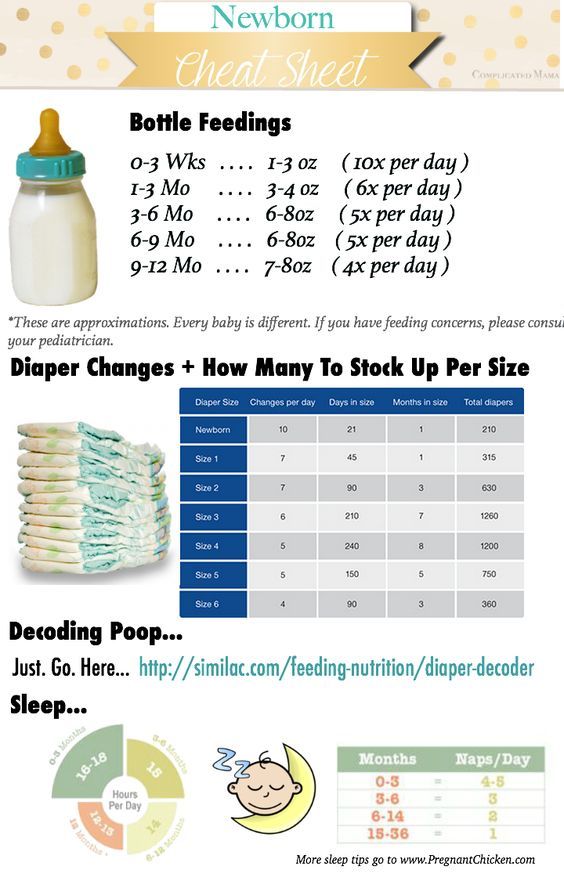 Maternal secretory immunoglobulin A provides protection against infection of the vital organs and systems of the child.
Maternal secretory immunoglobulin A provides protection against infection of the vital organs and systems of the child.
- Human milk lactoferrin plays an exceptional role in protecting the baby from viral infections, preventing the penetration of viral particles through the cell membrane, thus preventing infection from entering the baby's body. In addition to the antiviral action, lactoferrin also has antibacterial properties. Many microorganisms contain receptors for lactoferrin on their surface, and the binding of lactoferrin to the corresponding receptor leads to the death of a foreign bacterial cell. Lactoferrin has a bactericidal effect against a large number of gram-positive and gram-negative bacteria.
- the bifidus factor of human milk is represented by a whole complex of various sugars (oligosaccharides) and their monomers: beta-lactose, galactooligosaccharides, D-glucose, D-galactose, N-acetylglucosamines, L-fucose and sialic acids. The bifidus factor of human milk stimulates the formation of the intestinal microflora, mainly consisting of bifidobacteria (B. Bifidum) and lactobacilli. Normal intestinal microflora lines the intestinal crypts like a blanket, creating a protective layer that prevents foreign bacteria and allergens from entering the baby's circulatory system. Also, bifido- and lactobacilli create a favorable intra-intestinal environment with a shift in the pH of the contents of the colon to the acid side, which inhibits the growth of pathogenic and conditionally pathogenic bacteria and promotes the absorption of iron, calcium, vitamin D and other micro- and macroelements; participates in the synthesis of vitamins B1, B2, B3, PP, B6, B12, folic acid, biotin. In addition, the normal intestinal microflora makes the baby's immunity stronger.
Bifidum) and lactobacilli. Normal intestinal microflora lines the intestinal crypts like a blanket, creating a protective layer that prevents foreign bacteria and allergens from entering the baby's circulatory system. Also, bifido- and lactobacilli create a favorable intra-intestinal environment with a shift in the pH of the contents of the colon to the acid side, which inhibits the growth of pathogenic and conditionally pathogenic bacteria and promotes the absorption of iron, calcium, vitamin D and other micro- and macroelements; participates in the synthesis of vitamins B1, B2, B3, PP, B6, B12, folic acid, biotin. In addition, the normal intestinal microflora makes the baby's immunity stronger.
At present, using the latest scientific methods, the existence of oligosaccharides containing up to 32 sugar fragments and up to 15 fructose fragments has been established. This means that the number of different types of oligosaccharides in human breast milk can reach several tens of thousands of units. Naturally, even modern artificial mixtures containing prebiotics (industrial analogues of the bifidus factor) cannot be compared in quality and variety with breast milk.
Naturally, even modern artificial mixtures containing prebiotics (industrial analogues of the bifidus factor) cannot be compared in quality and variety with breast milk.
Urinary system:
- The formation of the child's urinary system and the development of its functions takes place in the first year of life. In an infant at the time of birth, the plasma flow and the process of formation of primary urine by filtering plasma in the renal glomeruli are reduced, osmotic concentration of urine is not effective enough. The main indicators of kidney function come to the level of an adult by the beginning of the second year of life. Therefore, it is very important that the load on the kidneys, depending on the content of proteins and mineral salts in the food taken, be adequate to the physiological age of the child.
- The protein level in women's milk averages from 0.8 to 1.2 g / 100 ml, while even in the adapted ready-made milk formula this figure is 40 - 70% higher and is 1.
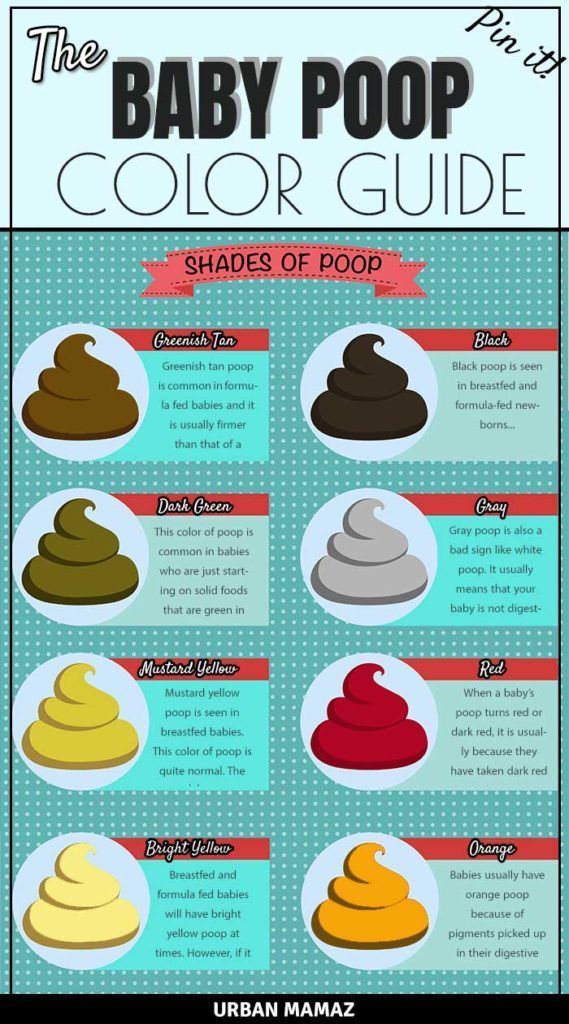 4 - 1, 6 g/100 ml. The increased content of proteins increases the load on the glomerular apparatus of the kidney.
4 - 1, 6 g/100 ml. The increased content of proteins increases the load on the glomerular apparatus of the kidney. - Another problem with milk mixtures is their normalization by mineral composition. Excess salt can overload the kidneys and cause thirst, which is reflected in the addition of water to formula-fed babies.
- Many pediatricians still recommend giving babies about 100 ml of water daily to avoid dehydration. However, at present, the World Health Organization and UNICEF insist that there is no need for supplementation and the introduction of any foreign liquids and products before the child reaches the age of 6 months.
- What is the basis for these recommendations? If breastfeeding is organized correctly (the mother feeds the baby on demand, approximately every 1.5 - 2 hours, keeping night feedings), then the baby receives enough water from milk in the first six months of life.
This section describes only the main advantages of breastfeeding.
Is there any benefit from breastfeeding for the mother and does this process affect the “usual” way of life?
The benefits for the mother can be divided into three groups:
1. Health benefits
- Breastfeeding within the first hour after birth significantly reduces the risk of postpartum uterine bleeding.
- Breastfeeding maintains a high level of hormones (oxytocin and prolactin) in the blood of the mother, which contributes to the formation of strong maternal feelings.
- If a woman breastfeeds her baby exclusively, then in the first 4-6 months after birth, the probability of pregnancy is reduced by 95%.
- Long-term breastfeeding reduces the risk of breast cancer by 50%, and if a mother breastfeeds multiple children, breastfeeding each child reduces the risk of ovarian cancer by 25%. Also, women who breastfeed for a long time are less likely to suffer from osteoporosis.\
2. Economic benefits
- You don't need to buy breast milk, you don't need additional accessories - nipples, sterilizers, heaters, breast pumps, which you still need to run around and choose exactly those that fit the size and shape of your breasts.

- Savings on artificial mixtures, which are not cheap at all.
3. Breastfeeding is convenient
From a practical point of view, breastfeeding makes life easier for mothers. Breast milk is always sterile, at the ideal temperature and composition, requires no preparation, and is always fresh and ready to drink. It is convenient that a mother can feed a child in any conditions: in transport, at a party, in nature - in those places where preparing baby food is difficult and dangerous due to infection.
Undoubtedly, breastfeeding has its own difficulties, however, it depends only on you whether your child will receive the benefits necessary for life: good health, an adequate level of physical and mental development, social adaptation in society.
Doctor -pediatrician of the highest category
Motina Irina Vyacheslavovna
newborn feeding regimen on IV, how to properly feed a baby with formula from a bottle
The desire for a child to grow up strong and healthy is natural for mothers.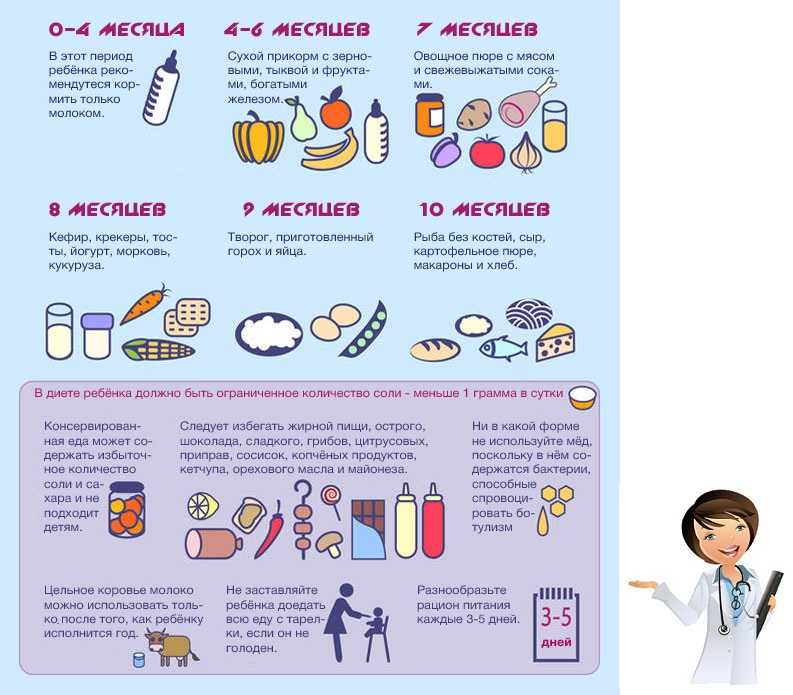 And the health of a newborn begins with proper nutrition. Mother's milk has always been considered the best option for feeding - the most healthy and nutritious food for infants. However, in some cases, breastfeeding is not possible. And then mixtures come to the aid of mothers.
And the health of a newborn begins with proper nutrition. Mother's milk has always been considered the best option for feeding - the most healthy and nutritious food for infants. However, in some cases, breastfeeding is not possible. And then mixtures come to the aid of mothers.
Contents: Hide
- In what cases is the transition to artificial feeding
- How to choose a mixture
- Basic rules of artificial feeding
- Model
- The main errors with artificial feeding. to breastfeeding. There are a number of diseases in which breast milk is prohibited. On the mother's side, these are HIV, an open form of tuberculosis, dangerous infections, and a serious state of health. On the part of the child, these are leucinosis, galactosemia, and individual food intolerance. It is not necessary to take tests after hearing the terrible names of diseases. All newborns are checked in maternity hospitals for their presence. But allergies are not so easy to identify.
Many newborns have skin rashes and redness, which may be due to a reaction to an aggressive environment. Only a strict diet for the mother can help here, so that her milk does not contain allergens, monitoring the baby and consulting a doctor.
Lack of lactation or its complete cessation. This is the second objective reason for transferring a child from breast milk to formula. Lactation does not always come in the right amount and it can be increased. It happens that milk disappears a few days after the birth of the crumbs. This often depends on the individual characteristics of the mother's body. So that the child does not starve, he is first transferred to mixed, and then completely to artificial feeding.
Insufficient nutritional value of mother's milk. Usually this problem can be solved without resorting to the transition to IoT, but this is not always possible. A woman may have a lot of milk, but it will be like water in both color and consistency. In such cases, doctors give advice to the mother on nutrition in order to increase the fat content of milk and its usefulness.
If the milk remains watery, the child stops eating, cries of hunger, loses weight. The only way out in this situation is the transition to the mixture.
Impossibility of regular feeding. Children who, for a number of reasons, are separated from their mother for long periods of time are transferred to artificial feeding: the woman is in a hospital, going to work or study, business trips, etc. If the break in breastfeeding is one-time, then restoring lactation and breastfeeding is still possible . However, more often in such cases, breastfeeding has to be abandoned.
Mother's personal wish. Unfortunately, there are cases when a woman, having every opportunity to breastfeed her baby, refuses to breastfeed for various subjective reasons. In this case, lactation is interrupted, and the baby is transferred to the mixture.
See also: Newborn weight gain by month
How to choose a formula
If you are going to transfer your baby to artificial feeding, then the first thing you will encounter will be the choice of nutrition.
Today there are a large number of different mixtures: adapted and non-adapted, dairy and sour-milk, dry and liquid. There are mixtures against regurgitation, hypoallergenic, for premature babies, etc. How to choose the optimal replacement for mother's milk from such a variety?
- Make your choice only after consulting a pediatrician. The doctor will examine the baby and give all the necessary recommendations.
- Monitor your child. When adapting to a new diet, the child may have small rashes, but they disappear if the body begins to absorb the mixture normally. The baby eats with appetite, he has a normal stool and no colic. Otherwise, the mixture must be changed.
- If there is a need to replace the mixture with a thicker one (anti regurgitation), choose the same brand of food that was previously used.
- Consider the baby's age. All mixtures have a gradation by months of life.
- Prefer adapted formulas, they are usually easier to digest
Basic rules for formula feeding save you a lot of problems.
1. Choose proven blends. This applies not only to the choice of brand, but also to the packaging itself. Look at its integrity, check the expiration date.
2. Observe the storage conditions of the opened package at home (in a dry and cool place, but in no case in the refrigerator, the mixture must not become damp). Remember that the open mixture is stored for three weeks. After this period, it can no longer be used.
3. Strictly follow the instructions when preparing meals. It is indicated on the packaging. Water for the preparation of the mixture must be purified and boiled. The optimal temperature for preparing the mixture is 36–37 °C. You can cook food right in the bottle. This is quite convenient, since baby bottles have a volume scale that makes it easier to calculate the right amount of scoops. The mixture must be stirred until completely dissolved, and then cooled to an acceptable temperature so that the baby can drink without burning himself. You can check if the milk is hot by dropping it on your wrist - there the skin is most tender and sensitive.
If the temperature is almost not felt, then the mixture can be given to the child.
4. Sterilize baby dishes. Baby bottles and nipples should be thoroughly rinsed using a special brush so that no food residue remains. You can use children's dishwashing detergents. Do not wash bottles with common cleaning products that you are used to using, no matter how good they are. After washing, be sure to place the dishes in boiling water. This helps to kill harmful bacteria. It is recommended to sterilize children's dishes during the entire first year of a baby's life. Then you can limit yourself to just a thorough wash.
5. Hold the bottle in a semi-vertical position when feeding. The milk should completely fill the nipple. This prevents the child from swallowing air. After feeding, it is necessary to hold the baby in a column for several minutes to avoid spitting up.
6. Monitor the amount of formula consumed and the feeding schedule. Maintaining a balance is extremely important for the healthy and full development of the baby.

- Calculate the amount of formula to be prepared based on the baby's weight. It is body weight, and not the age of the crumbs, that is the main indicator when calculating the daily nutritional intake. You can find out the required volume of the mixture for feeding either at a pediatrician’s appointment, or on your own (it is recommended to use Maslov’s caloric method when calculating).
- Observe breaks between feedings. During the day they should be 3.5 hours, at night - 6. Try not to break the schedule.
- Give the child water. Supplementation with water is a necessity for artificial feeding. Water should be given somewhere in the middle of the interval between feedings or 10-15 minutes after it. Avoid supplementation before meals.
Major mistakes in artificial feeding
Overfeeding. The desire to feed the child is understandable, but in the case of mixtures, feeding must be approached strictly. On artificial feeding, the child is normally gaining weight very well.
 Excess body weight is an additional burden on the body and health problems. Even an adult can find it difficult to cope with problems from being overweight. What to say about the tiny weak body of a newborn? Follow the diet and control the daily milk intake. Fortunately, you can always see how much the child ate.
Excess body weight is an additional burden on the body and health problems. Even an adult can find it difficult to cope with problems from being overweight. What to say about the tiny weak body of a newborn? Follow the diet and control the daily milk intake. Fortunately, you can always see how much the child ate. Unreasonable replacement of the mixture. If the child eats the current mixture well, then it is not necessary to change it. The baby will have to go through a difficult period of adaptation again, and it’s not a fact that his body will accept new food just as well.
Use of old mix. The child's food must be fresh. If the child has not finished eating, then literally after half an hour the milk can only be poured out. Milk mixtures are an excellent environment for the life of pathogenic bacteria.
Pet milk feeding. Do you think this is a more natural option than artificial mixtures? This is an erroneous opinion. For a child under one year old, cow or goat milk, even boiled, is strictly prohibited.



